2000 BMW 323i SEDAN child restraint
[x] Cancel search: child restraintPage 10 of 189

Contents
Overview
Controls and features
Cockpit16
Instrument cluster18
Indicator and warning lamps20
Multifunction steering wheel
(MFL)24
Hazard warning flashers25
Warning triangle25
First-aid kit25
Refueling26
Fuel specifications26
Tire inflation pressure27
Locks and security systems:
Keys32
Electronic vehicle
immobilizer33
Central locking system34
Opening and closing Ð from
outside34
Opening and closing Ð from
inside38
Luggage compartment lid39
Luggage compartment41
Alarm system42
Electric power windows44
Sliding/Tilt sunroof45
Adjustments:
Seats47
Seat and mirror memory50
Steering wheel51
Mirrors52
Car Memory, Key Memory53
Passenger safety systems:
Safety belts54
Child restraint systems55
Child-safety locks56
Airbags56
Child restraints59
Installing a child restraint
system60
Driving:
Steering/Ignition lock61
Starting the engine61
Switching off the engine62
Parking brake63
Manual transmission64
Automatic transmission with
Steptronic65
Turn signal indicator/Headlamp
flasher68
Wiper/Washer system/Rain
sensor68
Rear window defroster70
Cruise control71
Everything under control:
Odometer73
Tachometer73
Energy Control73
Fuel gauge74
Temperature gauge74
Service Interval Display74
Check Control75
Clock75
Onboard computer76
Technology for safety and
convenience:
Park Distance Control (PDC)78
Dynamic Stability Control
(DSC)79
Tire Pressure Control (RDC)80
Contents
Page 30 of 189
30n
Controls Locks and security systems:
Keys32
Electronic vehicle
immobilizer33
Central locking system34
Opening and closing Ð from
outside34
Opening and closing Ð from
inside38
Luggage compartment lid39
Luggage compartment41
Alarm system42
Electric power windows44
Sliding/Tilt sunroof45
Adjustments:
Seats47
Seat and mirror memory50
Steering wheel51
Mirrors52
Car Memory, Key Memory53
Passenger safety systems:
Safety belts54
Child restraint systems55
Child-safety locks56
Airbags56
Child restraints59
Installing a child restraint
system60
Page 55 of 189
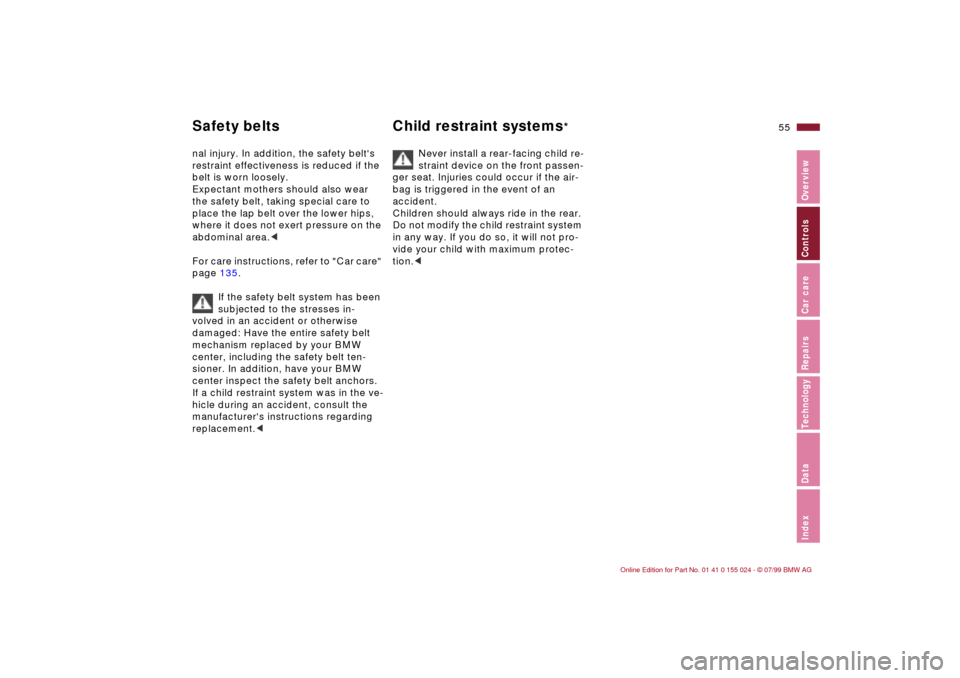
55n
IndexDataTechnologyRepairsCar careControlsOverview
Safety belts Child restraint systems
*
nal injury. In addition, the safety belt's
restraint effectiveness is reduced if the
belt is worn loosely.
Expectant mothers should also wear
the safety belt, taking special care to
place the lap belt over the lower hips,
where it does not exert pressure on the
abdominal area.<
For care instructions, refer to "Car care"
page 135.
If the safety belt system has been
subjected to the stresses in-
volved in an accident or otherwise
damaged: Have the entire safety belt
mechanism replaced by your BMW
center, including the safety belt ten-
sioner. In addition, have your BMW
center inspect the safety belt anchors.
If a child restraint system was in the ve-
hicle during an accident, consult the
manufacturer's instructions regarding
replacement.<
Never install a rear-facing child re-
straint device on the front passen-
ger seat. Injuries could occur if the air-
bag is triggered in the event of an
accident.
Children should always ride in the rear.
Do not modify the child restraint system
in any way. If you do so, it will not pro-
vide your child with maximum protec-
tion.<
Page 57 of 189

57n
IndexDataTechnologyRepairsCar careControlsOverview
AirbagsIndicator lamp
The indicator lamp displays the
operational status of the airbag
system when the ignition key is
in position 1 and higher.
System operational:
>The indicator lamp comes on briefly
then goes out.
System malfunction:
>The indicator lamp fails to come on.
>The indicator lamp comes on briefly
before going out, and then lights up
again.
If there is a system malfunction, there is
a risk that the airbags will not be trig-
gered within their normal response
range, even if the level of impact would
normally have triggered them.
Have your BMW center inspect and
repair the system immediately.
The airbag indicator lamp also
comes on if the safety belt ten-
sioners have been triggered.<
For your own safety, please com-
ply with the following precautions
concerning airbags. If you do not, their
protective function may be impaired
and your personal safety endangered.
The following information pertains to all
occupants:
The airbags are supplemental restraint
devices designed to provide extra pro-
tection; they are not a substitute for
safety belts. Wear your safety belt at all
times. The airbags will not be triggered
in the event of a minor accident, a vehi-
cle roll-over, or collisions from the rear.
In these instances, the safety belt offers
the best protection.
Airbags are located under the cover
panels in the steering wheel, in the in-
strument panel, in the side trim panels
in the front and rear
*, in the roof panels,
and in the sides of the inside roof lining.
Select a seat position that is comfort-
able and allows the greatest possible
distance from each of the applicable air-
bags. Hold the steering wheel at the rim
(hands at the "9 o'clock and 3 o'clock"
positions) in order to avoid injuries to
your hands or arms if the airbag is trig-
gered.
Never allow any objects to obstruct the
area between the airbag and an occu-
pant.
Do not use the cover panel above the
front passenger airbag as a storage
area.
Never tape the airbag cover panels,
cover them over or alter them in any
other way.
Never install a rear-facing child restraint
device on the front passenger seat. Chil-
dren under 13 years of age and children
who are smaller than 5 feet (150 cm),
should only travel in the rear seat.
If your vehicle is equipped with side air-
bags in the rear, be sure that child seats
are installed correctly and with the
greatest possible distance from the side
trim panels. Do not allow children to
lean out of the child's seat in the direc-
tion of the side trim panels. Otherwise,
serious injuries could occur if the airbag
is triggered.
At all times, occupants should sit up-
right and be properly restrained (infants
and small children in appropriate child
restraint systems; larger children and
adults using the safety belts). Never let
an occupant's head rest near or on a
side airbag because the inflating airbag
could cause a serious or fatal injury.
Please note that the word "Airbag" im-
printed on the door trim panel indicates
the airbag's location.
Page 58 of 189
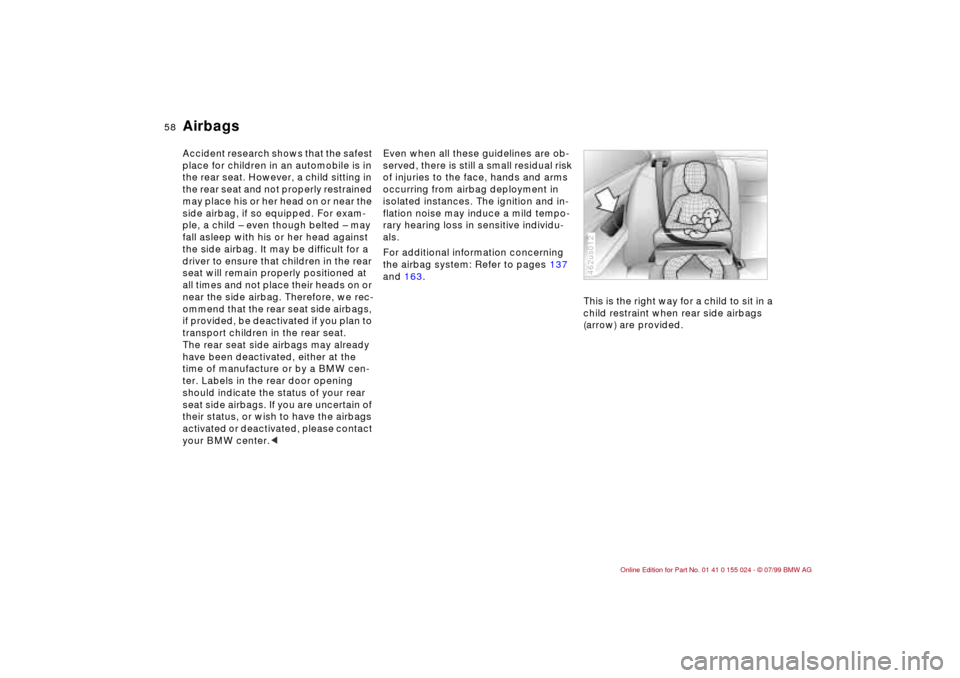
58n
AirbagsAccident research shows that the safest
place for children in an automobile is in
the rear seat. However, a child sitting in
the rear seat and not properly restrained
may place his or her head on or near the
side airbag, if so equipped. For exam-
ple, a child Ð even though belted Ð may
fall asleep with his or her head against
the side airbag. It may be difficult for a
driver to ensure that children in the rear
seat will remain properly positioned at
all times and not place their heads on or
near the side airbag. Therefore, we rec-
ommend that the rear seat side airbags,
if provided, be deactivated if you plan to
transport children in the rear seat.
The rear seat side airbags may already
have been deactivated, either at the
time of manufacture or by a BMW cen-
ter. Labels in the rear door opening
should indicate the status of your rear
seat side airbags. If you are uncertain of
their status, or wish to have the airbags
activated or deactivated, please contact
your BMW center.
of injuries to the face, hands and arms
occurring from airbag deployment in
isolated instances. The ignition and in-
flation noise may induce a mild tempo-
rary hearing loss in sensitive individu-
als.
For additional information concerning
the airbag system: Refer to pages 137
and 163.
This is the right way for a child to sit in a
child restraint when rear side airbags
(arrow) are provided.
462us012
Page 59 of 189
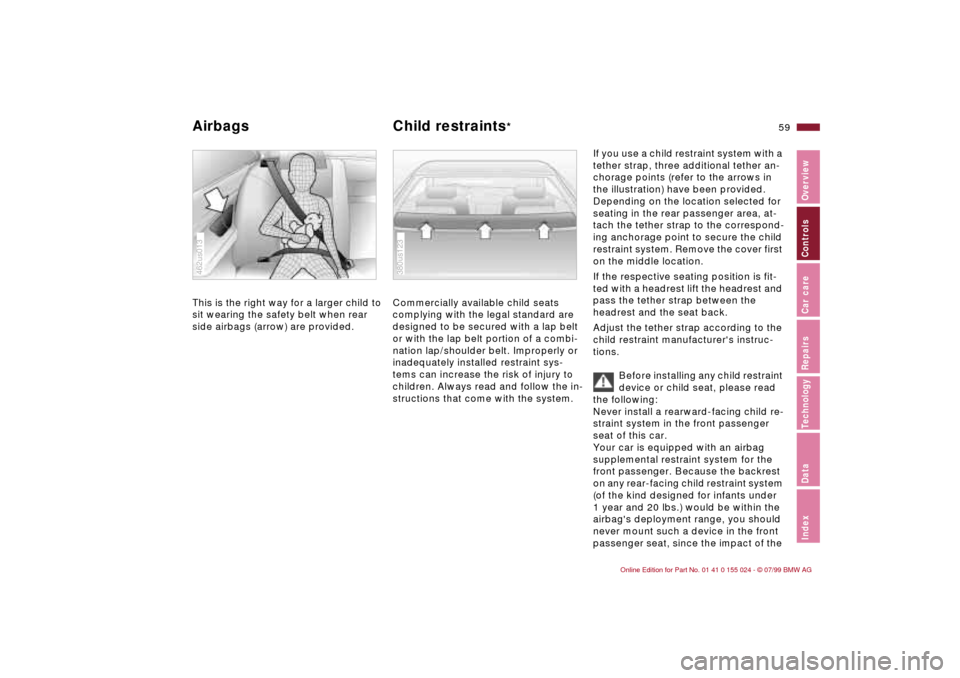
59n
IndexDataTechnologyRepairsCar careControlsOverview
Airbags Child restraints
*
This is the right way for a larger child to
sit wearing the safety belt when rear
side airbags (arrow) are provided.462us013
Commercially available child seats
complying with the legal standard are
designed to be secured with a lap belt
or with the lap belt portion of a combi-
nation lap/shoulder belt. Improperly or
inadequately installed restraint sys-
tems can increase the risk of injury to
children. Always read and follow the in-
structions that come with the system.380us123
If you use a child restraint system with a
tether strap, three additional tether an-
chorage points (refer to the arrows in
the illustration) have been provided.
Depending on the location selected for
seating in the rear passenger area, at-
tach the tether strap to the correspond-
ing anchorage point to secure the child
restraint system. Remove the cover first
on the middle location.
If the respective seating position is fit-
ted with a headrest lift the headrest and
pass the tether strap between the
headrest and the seat back.
Adjust the tether strap according to the
child restraint manufacturer's instruc-
tions.
Before installing any child restraint
device or child seat, please read
the following:
Never install a rearward-facing child re-
straint system in the front passenger
seat of this car.
Your car is equipped with an airbag
supplemental restraint system for the
front passenger. Because the backrest
on any rear-facing child restraint system
(of the kind designed for infants under
1 year and 20 lbs.) would be within the
airbag's deployment range, you should
never mount such a device in the front
passenger seat, since the impact of the
Page 60 of 189
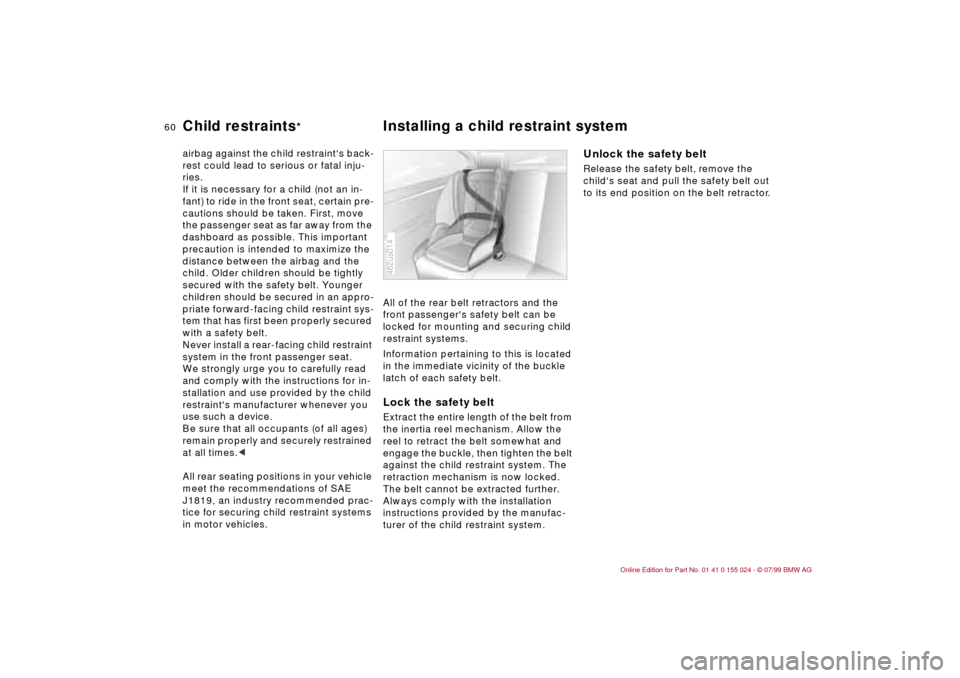
60n
Child restraints
*
Installing a child restraint system
airbag against the child restraint's back-
rest could lead to serious or fatal inju-
ries.
If it is necessary for a child (not an in-
fant) to ride in the front seat, certain pre-
cautions should be taken. First, move
the passenger seat as far away from the
dashboard as possible. This important
precaution is intended to maximize the
distance between the airbag and the
child. Older children should be tightly
secured with the safety belt. Younger
children should be secured in an appro-
priate forward-facing child restraint sys-
tem that has first been properly secured
with a safety belt.
Never install a rear-facing child restraint
system in the front passenger seat.
We strongly urge you to carefully read
and comply with the instructions for in-
stallation and use provided by the child
restraint's manufacturer whenever you
use such a device.
Be sure that all occupants (of all ages)
remain properly and securely restrained
at all times.c
All rear seating positions in your vehicle
meet the recommendations of SAE
J1819, an industry recommended prac-
tice for securing child restraint systems
in motor vehicles.All of the rear belt retractors and the
front passenger's safety belt can be
locked for mounting and securing child
restraint systems.
Information pertaining to this is located
in the immediate vicinity of the buckle
latch of each safety belt.
Lock the safety beltExtract the entire length of the belt from
the inertia reel mechanism. Allow the
reel to retract the belt somewhat and
engage the buckle, then tighten the belt
against the child restraint system. The
retraction mechanism is now locked.
The belt cannot be extracted further.
Always comply with the installation
instructions provided by the manufac-
turer of the child restraint system.462us014
Unlock the safety beltRelease the safety belt, remove the
child's seat and pull the safety belt out
to its end position on the belt retractor.
Page 180 of 189

Everything from A to ZAABS (Antilock Brake
System)22, 106
Accessories6
Activated-charcoal
filter90, 155
Adaptive Transmission
Control (ATC)65, 162
Adding engine oil125
Adding washer
fluid124, 175
Adjusting the backrest47
Adjusting the steering
wheel51
Adjusting the thigh support
area49
Air distribution88
Air nozzles86
Air outlets86
ventilation86
Air pressure113
Air supply89
Airbags21, 56, 137, 163
Alarm system42
Antenna112
Antenna, Diversity164
Antifreeze128
radiator110
Antilock Brake System
(ABS)22, 106
Anti-theft alarm system42
Aquaplaning104, 113
Armrest93Ashtray95
front95
rear96
ATC (Adaptive Transmission
Control)65, 162
AUC (Automatic
recirculated-air
control)89
Automatic car washes132
Automatic climate
control86
removing condensation
from the windows89
Automatic cruise control71
Automatic dimming, interior
rearview mirror53
Automatic recirculated-air
control (AUC)89
Automatic transmission with
Steptronic22, 65
Automatic windshield
washer69
Average consumption77
Average speed77
Axle loads174
BBackup lamps64
bulb replacement145
Battery152, 176
capacity176
charge154discharged157
removal and
installation153
Battery charge current20
Battery Safety Terminal
(BST)153
Belts54
Blower89
BMW High Performance
Synthetic Oils126
BMW Sports Seat49
Bore172
Brake fluid129
Brake hydraulic system20
Brake lamps
bulb replacement145
Brake pads22
Brakes108
malfunctions109
Break-in procedure104
Breaking in the vehicle104
BST (Battery Safety
Terminal)153
Bulb replacement142
CCapacities175
Car Memory53
Car radio112
refer also to the separate
Owner's ManualCar radio
reception112, 164
Car vacuum cleaner,
connecting96
Car wash132
Care
exterior133
interior134
Care of upholstery135
Care of wool velour135
Cargo loading99
Caring for the vehicle
finish133
Catalytic converter105
CBC (Cornering Brake
Control)21, 107
Cellular phone95, 112
refer also to the separate
Owner's Manual
Center (high-mount) brake
lamp147
Center armrest93
Central locking system34
button38
Changing a tire149
Changing a wheel149
Charge indicator lamp20
Check Control75
Child restraint
systems55, 59
Child seat59
Child-safety locks56
Cigarette lighter96
Everything from A-Z